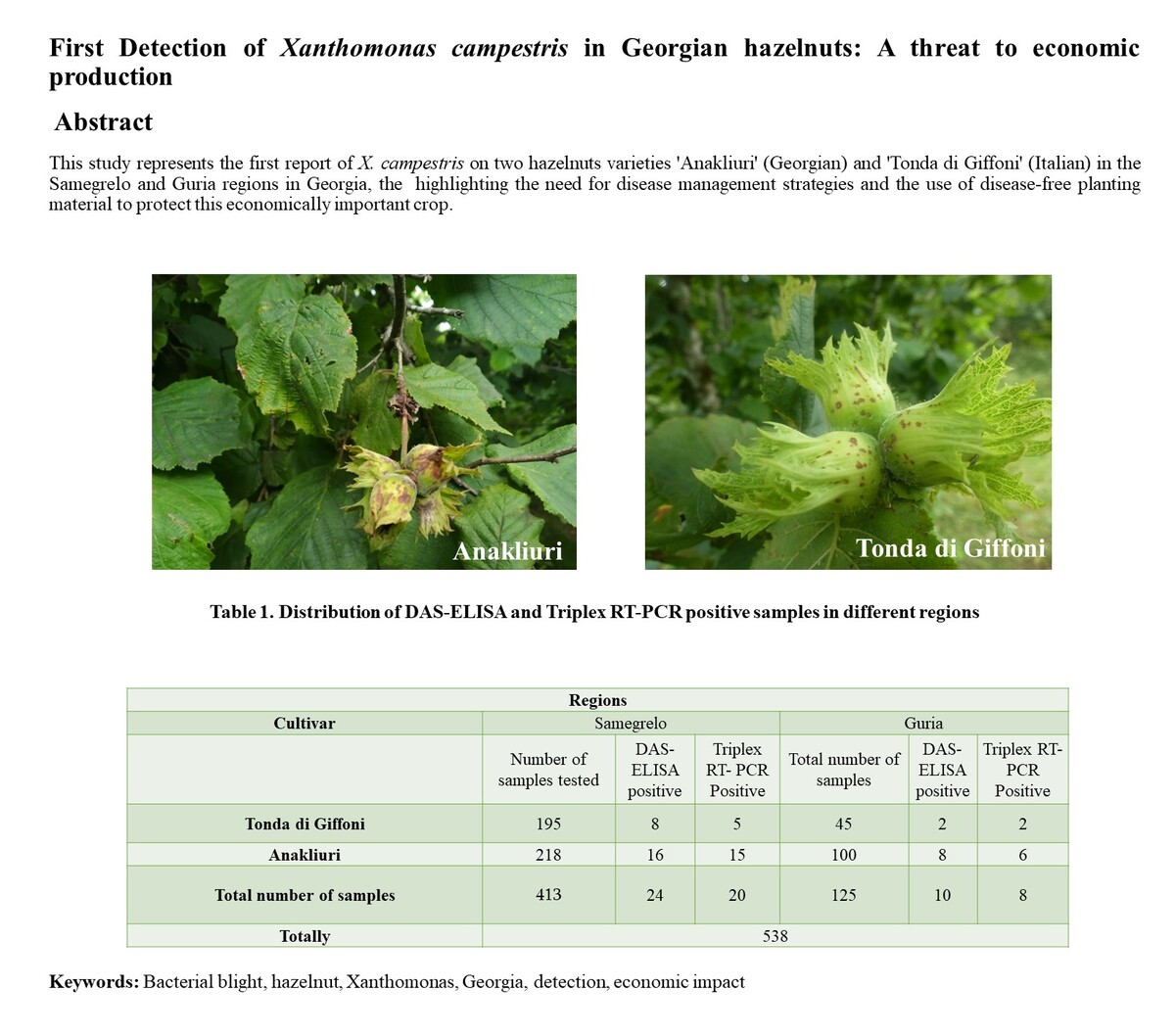RAPID COMMUNICATION
First Detection of Xanthomonas campestris in Georgian hazelnuts: A threat to economic production
1
Integrated Plant Protection Research, LEPL Scientific Research Center of Agriculture, Marshal gelovani Ave, 36b, 0175, Tbilisi, Georgia
2
School of Science and Technology, University of Georgia, 77a M. Kostava str.,, 0171, Tbilisi, Georgia
3
Dept. of Plants and Crops, Faculty of Bioscience Engineering, Ghent University, Valentin Vaerwyckweg 1, B-9000, Ghent, Belgium
These authors had equal contribution to this work
A - Research concept and design; B - Collection and/or assembly of data; C - Data analysis and interpretation; D - Writing the article; E - Critical revision of the article; F - Final approval of article
Submission date: 2025-05-09
Acceptance date: 2025-10-22
Online publication date: 2025-11-03
Corresponding author
Iveta Megrelishvili
Integrated Plant Protection Research, LEPL Scientific Research Center of Agriculture, Marshal gelovani Ave, 36b, 0175, Tbilisi, Georgia
Integrated Plant Protection Research, LEPL Scientific Research Center of Agriculture, Marshal gelovani Ave, 36b, 0175, Tbilisi, Georgia
HIGHLIGHTS
- Bacterial blight symptoms have been observed on hazelnut cultivars in Georgia
- X. campetries was detected using ELISA, TaqMan triplex real-time PCR and sequencing
- This represents the first report of X. campestris in Georgia
KEYWORDS
TOPICS
ABSTRACT
Bacterial blight, caused by Xanthomonas campestris is a major disease of hazelnut (Corylus avellana) worldwide. Georgia is a significant hazelnut producer, but the presence of X. campestris has not been previously confirmed.
In 2022-2023, hazelnut plants in nurseries across western Georgia were observed with symptoms of bacterial blight. Samples, including 538 symptomatic samples of both 'Anakliuri' (Georgian) and 'Tonda di Giffoni' (Italian) hazelnut cultivars, were collected from the Samegrelo and Guria regions in Georgia. DAS-ELISA with polyclonal antibodies identified 34 potentially positive for X. campestris. Additionally, samples were cultured on YPGA and King's medium B for presumptive X. campestris identification based on yellow colonies with subsequent confirmation of 28 samples by a TaqMan triplex real-time PCR assay using species-specific primers. Sanger sequencing of the 16S rRNA gene, performed on 24 of these, with further BLAST analysis, revealed four isolates as X. campestris (GenBank Accession Numbers: PP437082.1, PP434581.1, PP434578.1, PP434556.1) showing up to 100% nucleotide identity to X. campestris pv. campestris strains isolated from different countries (India, Serbia, and Mexico) and sources.
Pathogenicity was confirmed by inoculating young shoots (20-30 cm long) of 2-year-old potted hazelnut plants (‘Hall's Giant’) with a bacterial suspension (108 CFU/ml) of each isolate. Bacterial cultures were re-isolated, fulfilling Koch's postulates.
This represents the first report of X. campestris in Georgia, highlighting the need for disease management strategies and the use of disease-free planting material to protect this economically important crop.
CONFLICT OF INTEREST
The authors have declared that no conflict of interests exist.
We process personal data collected when visiting the website. The function of obtaining information about users and their behavior is carried out by voluntarily entered information in forms and saving cookies in end devices. Data, including cookies, are used to provide services, improve the user experience and to analyze the traffic in accordance with the Privacy policy. Data are also collected and processed by Google Analytics tool (more).
You can change cookies settings in your browser. Restricted use of cookies in the browser configuration may affect some functionalities of the website.
You can change cookies settings in your browser. Restricted use of cookies in the browser configuration may affect some functionalities of the website.




